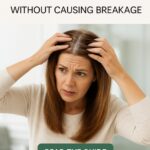
Going from blonde to black sounds simple. You look in the mirror, you’re tired of the yellow, and you just want to be dark, glossy, done. But if the hair under that black dye is bleached, you have to slow down and do it right or you’ll end up with gummy, frizzy ends that will not stop breaking.
This guide walks through what actually happens when you put black dye on bleached hair, how to prep so your texture survives, and how to avoid the dreaded swampy green cast. We’ll also cover when you should not do it yourself at all.
Why bleached hair behaves differently
Bleach is not color. Bleach is damage. When you bleach, you are stripping pigment out of the hair and also weakening the internal bonds that keep your strands smooth and springy. That is why hair that has been lifted can feel stretchy when it is wet and rough when it is dry. It is literally more fragile than your natural roots.
When you put dark color straight on top of that, a couple things can go wrong if you are not careful.
First, bleached hair can grab black dye unevenly. The most damaged areas soak up tons of pigment and go matte ink-black. The less damaged areas might not grab the undertones they need, so they sit more charcoal or even a weird swamp dark green. You think you are getting rich black, but in sunlight it looks off.
Second, if the hair is already weak, forcing more chemical processing can tip it over into breakage. You rinse and you see little broken pieces in the sink. The ends feel rough, thin, and almost see-through. That is texture loss, and it is really hard to come back from.
Third, if you treat this like a normal box dye situation and drag permanent black dye from your scalp to your ends, you also create banding. Banding is when your mids and ends go way darker than your root area and you can see a harsh line where it changes. It is super common when people go from bleached blonde back to dark at home, and it looks cheap immediately.
So the answer to “can I just put black dye over bleached hair” is yes, but only if you rebuild a little first, layer color in the right order, and control how the dye hits the strand. That is exactly why we made our breakdown of shades in Best Black Hair Dye. Deep color can be beautiful and soft if you treat it like recovery, not revenge.
Step one: check your current hair health before you even buy dye
Before you color anything, do a quick texture check in the shower. Get your hair wet, take a small section from the ends, and gently pull. Healthy hair has a little elastic give, then bounces back. Over-processed hair stretches like warm chewing gum and does not snap back to its original length. If your hair feels gummy, that means the internal structure is already weakened. Putting permanent dye on top of that can push it into full break mode.
Now look at your ends in normal daylight. Do they look thin and see-through at the last inch or two, almost like frayed thread instead of a solid line? That is breakage starting. Once hair looks like that, it is at the edge of what it can handle. You want to trim that off or at least baby it with repair masks before you try to force pigment in.
Finally, touch your scalp and hairline. If you are already dealing with irritation from your last bleaching session, stinging around the ears, flakes, or tenderness, you should not put permanent dye right on that skin today. Give your scalp time to calm down. We walk through protecting your skin from staining and irritation when you’re coloring in How to Get Hair Dye Off Skin, and that same prep matters here.
If your hair fails those checks, pause. Do not skip this and hope. Bleached hair that is already gummy will not “get stronger” just because black dye is darker. Dark pigment does not equal healthy.
Step two: fill the hair before you go black
This is the part most people miss when they go from blonde to black at home. Hair that has been bleached is missing the warm underlying tones that naturally sit in darker hair. Natural brunette and black hair does not just have dark pigment. It has red and gold undertones underneath that help the final color look rich, soft, and believable. Bleached hair has had those tones pulled out.
If you slap a cool black dye directly on top of that pale, empty base, the dye sometimes has nothing to grab the way it expects. That is when you get that off, inky, almost greenish cast in the light instead of a soft black or espresso tone.
The fix is called filling. Filling is just putting warmth back into the hair before you go dark. In normal salon language, that usually means adding red, copper, or golden tone first so the hair has a base again, then putting the final dark shade on top.
At home, you can mimic this two-step process by first using a warm demi or semi tone in the brown/red family, letting that set, and then applying your final deep brown or black shade over it. You are basically rebuilding the missing warmth so the black sits correctly.
Yes, it is an extra step. Yes, it takes more time. It is also the difference between soft, believable black and harsh green-black that gives away that you panicked at 2 a.m.
If you are aiming for jet black with a cool finish, you still fill first. You are not trying to make your hair red. You are trying to stop the final black from looking flat, hollow, or weirdly gray on the ends. This is especially important on the most bleached, most fragile pieces around your face.
Step three: treat roots and mids/ends differently
When you go dark again, you cannot treat virgin roots and bleached ends like the same hair. They are not the same.
Your roots (new growth) are healthy, untouched hair with natural pigment still inside. They will grab and hold black dye fast. Your ends are light, porous, thirsty, and uneven. If you apply the same formula for the same amount of time from scalp to ends, you will almost always get two different results.
Here is the safer order.
Start with your mids and ends. Apply your filler shade first if you are doing a fill, then apply your target dark shade to the bleached sections first. Let that sit and start to take. Only after the mids and ends have had a head start do you apply dye to the roots.
Why. Roots are warm, alive, and process fast because of scalp heat. Ends are cooler and more damaged, so they can actually take color weirdly slow in some areas and way too fast in others. Giving the ends the first pass means they are not left behind looking smoky brown while your roots go shoe-polish black.
This is also how you avoid banding. Banding happens when you overlap permanent dye too many times on the same section of hair while your roots are always “fresh.” The mids and ends go darker and darker while the roots keep showing up slightly softer. By letting the ends go first and watching them, you can blend that transition instead of creating a hard line where you can literally see “this is where I dyed over bleach last month.”
We talk a lot about sectioning, timing, and only coating the hair you actually mean to process in How to Bleach Hair at Home. That same mindset applies here. You want clean, controlled placement, not “paint the whole head and pray.”
Step four: support the texture after you go dark
Going back to black does not magically repair bleach damage. Your hair may look shinier because darker shades reflect light more evenly, but the internal structure is still stressed. You have to baby it for a while if you do not want the ends to keep snapping.
Use repair masks that focus on bond support and softness. A bond-building or protein-support mask helps rebuild some of the missing strength so the hair is less stretchy and weak. A deep moisture mask helps smooth frizz and stop that straw feel. Rotate both. Do not just grab the heaviest mask you own and smother it all the time. Too much heavy moisture without strength can make bleached hair feel mushy. We walk through how often to use each type in Best Hair Masks for Bleached Hair.
Back off on daily high heat. If you are freshly colored, flat ironing your face-framing pieces at high temps every single morning is the fastest way to lose those pieces. That is why people think “black dye ruined my hair” when really it was bleach damage plus daily 400 degree heat on already stressed strands.
Sleep like you care. Satin or silk-style pillowcases and a loose braid or low bun at night cut down on friction. That matters a lot when your ends are already compromised from lifting and then recoloring.
Watch your ends. If they start looking see-through, ragged, or fuzzy at the tips within a week or two after going black, that is not normal “my hair is just dry.” That is active breakage. Get a light trim on the worst areas before that creep travels up the strand.
Final Thoughts
Yes, you can put black dye over bleached hair without destroying what is left of your texture, but only if you respect what bleach already did to the strand. You cannot just throw darkest black on dry, stretchy, over-processed hair and expect it to magically get glossy and strong.
Do a health check first. Fill the missing warmth so the color sits right. Apply in sections so you do not create harsh bands or snap your ends. Then baby the hair after you color so it can recover instead of shattering.
If you feel like your hair is already at the edge, or it turns to gum when it is wet, you should not force a permanent black on top of that today. Fix strength first. Color second. Long term, healthy dark hair looks better than rushed dark hair that breaks off at your jaw.
See also
If you are already thinking, “I just want it dark and done,” read Best Black Hair Dye next. It focuses on shades and finishes that look rich instead of flat and are easier to maintain on fragile hair. If you are still lifting or working with blonde pieces and want to understand the damage you are layering on top of, Best Hair Bleach and How to Bleach Hair at Home walk through safe sectioning, timing, and bond care so you are not stacking harsh processes on the same strands in the same week.
If your hair feels dry, stretchy, or rough after color changes, go look at Best Hair Masks for Bleached Hair for what to use during recovery instead of guessing. And if you are tempted to keep chasing lightness on top of damage, How to Lighten Hair Without Bleach explains what is actually realistic with high-lift color and sun-based tricks so you do not melt your ends trying to fix a shade you could have just toned or filled.
FAQs
1. Why does bleached hair sometimes turn green when I dye it black?
Because bleached hair is missing the warm red and gold tones that naturally sit under dark hair. If you skip that warm “fill” step and go straight to a cool black, the dye can read muddy or greenish in the light. Putting warmth back in first fixes that.
2. Can I just do roots and pull the rest through at the end?
Not if the mids and ends are bleached and fragile. Your roots are virgin and process fast. Your ends are weak and porous. You actually want to address the bleached mids and ends first, then blend into the roots so you do not create harsh dark bands.
3. Will going black make my hair feel healthier?
It might feel smoother for a little while because darker color can make the cuticle lie flatter and reflect light more evenly. But it does not rebuild the internal structure. If your hair is stretchy, gummy, or snapping, you still need strengthening and moisture care after coloring.
4. How soon after bleaching is it safe to go dark?
You can tone or fill fairly soon if your hair passed the stretch test and your scalp is calm. But if your hair feels weak or gummy when wet, wait. Forcing permanent dye right after aggressive bleach on already damaged hair is how you end up with full-on breakage at the ends.
5. Do I need to do a strand test first?
Yes. Take a small piece from underneath, run through the full plan (fill shade, then black), rinse, dry, and see both the color and the texture. If that strand feels weak or looks dull or greenish, adjust before you commit to your whole head. A 10 minute strand test can save you from a full head you hate.




